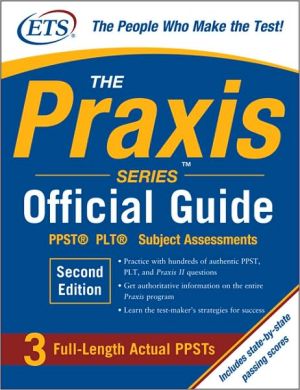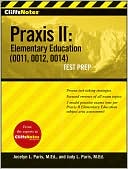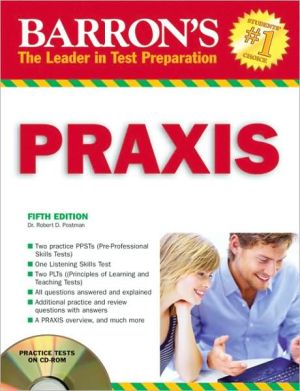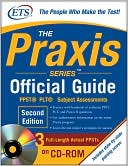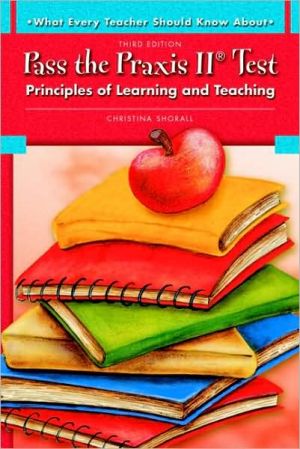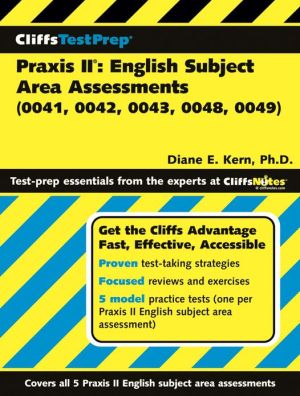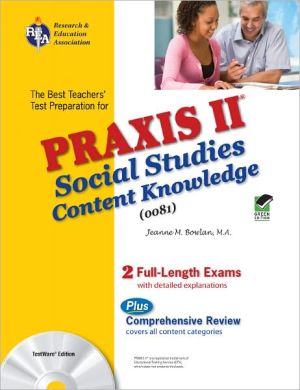CliffsTestPrep NYSTCE: Multi-Subject Content Specialty Test (CST)
Search in google:
Your guide to a higher score on the NYSTCE? Why CliffsTestPrep Guides? Go with the name you know and trust Get the information you need--fast! Written by test-prep specialists About the contents: Introduction * Overview of the test * Tips for answering multiple-choice questions Part I: Subject Review * Focused reviews cover all subjects tested, including: English Language Arts; Mathematics; Science and Technology; Social Studies; The Fine Arts; Health and Fitness; Family and Consumer Science and Career Development; Foundations of Reading: Constructed-Response Assignment * Subareas focus on specific skills within the subjects * Questions within the review sections emphasize key concepts and skills Part II: Two Full-Length Practice Tests * Practice tests are structured like the actual test * Answers and explanations help enhance your understanding and pinpoint areas for further review Test-Prep Essentials from the Experts at CliffsNotes? More than Notes! CliffsAP? CliffsComplete? CliffsQuickReview? CliffsTestPrep? CliffsStudySolver An American BookWorks Project Contributors: Linda Anderson, MFA; Jana Dixon, EdM; Sara Dubow, PhD; Chandra J. Foote, PhD; Debrah Goldberg, PhD; John Niman, PhD; Paula Pierson, MFA; Josette C. Seibles, PhD; Ken Springer, PhD; Mark Turner, DMA; Laraine Wallowitz, PhD
Introduction. About the Test. Subarea I: English Language Arts (21%). Subarea II: Mathematics (18%). Subarea III: Science and Technology (13%). Subarea IV: Social Studies (15%). Subarea V: The Fine Arts (8%). Subarea VI: Health and Fitness (8%). Subarea VII: Family and Consumer Science and Career Development (7%). Subarea VIII: Foundations of Reading: Constructed-Response Assignment (10%). Taking the Test. How to Answer Multiple-Choice Questions. The Constructed Response. Final Thoughts. PART I: SUBJECT REVIEW. Subarea 1: English Language Arts. Objective 0001. Levels of Literacy Development. Phonological and Phonemic Awareness. Print Concepts. The Alphabetic Principle. Word Identification Strategies. Constructing Meaning from Text. Review Questions. Objective 0002. Literal Comprehension Skills. Inferential Comprehension Skills. Evaluative Comprehension Skills. Reading Comprehension Strategies. Self-Monitoring Methods. Comprehension Assessment Methods. Review Questions. Objective 0003. Genre-Specific Reading Strategies. Information Resource Handling. Assessing Credibility or Objectivity. Visual Representations of Information. Literary Response Strategies. Reading for Enjoyment. Review Questions. Objective 0004. The Writing Process: Prewriting Strategies. The Writing Process: Note Taking, Outlining, and Drafting. The Writing Process: Revising Written Texts. The WritingProcess: Editing Written Texts. The Writing Process: Proofreading Written Texts. Using Technology to Research and Write. Review Questions. Objective 0005. Factors to Consider Before Writing. Incorporation of Graphics. Writing Research Papers. Credibility and Objectivity Enhancement. Writing Literary Responses. Voice Awareness. Review Questions. Objective 0006. Developing Listening Strategies. Factors in Effective Listening. Factors in Effective Spoken Communication. Varying Speaking Strategies. Communicating to Various Audiences. Applying Oral Language Conventions. Review Questions. Objective 0007. Fiction versus Nonfiction. Story Elements in Fiction. Dramatic Structure and Devices. Types of Nonfiction. Style, Tone, and Viewpoint. Elements of Poetry. Review Questions. Objective 0008. Time and Place Awareness. Cultural Values and Ideas Awareness. Themes and Characteristics in Children’s Literature. Important Works and Authors for Children and Adolescents. Themes and Elements in Childrens’ and Young Adult Literature. Review Questions. Subarea II: Mathematics. Objective 0009. Mathematical Relationships. Arguments and their Validity. Drawing Conclusions from Simple and Compound Statements. Using Inductive Reasoning. Problem-Solving Strategies. Review Questions. Objective 0010. Representing Relationships by Mathematical Notations. Visual Representation of Mathematical Concepts. Math Concepts Expressed through Language. Word Problems. Math Concepts Translated Into Equations. Mathematical Models. Review Questions. Objective 0011. Commutative, Distributive, and Associative Properties. Ratios, Proportions, and Percents. Converting Decimals to Fractions. Expressing Equivalent Forms of Numbers. The Division Algorithm. Simplifying Algebraic Expressions. Review Questions. Objective 0012. Describing Mathematical Relationships. Representing Patterns. Analyzing Patterns and Relationships. Deriving Algebraic Expressions. Algebraic Functions. Performing Algebraic Operations. Changing Variables. Review Questions. Objective 0013. Two- and Three-Dimensional Shapes. Using Basic Geometric Figures to Solve Problems. Similarity and Congruence. Inductive and Deductive Reasoning. Coordinate Geometry. Transformations and Symmetry. Review Questions. Objective 0014. Units of Measurement. Using the Correct Unit of Measurement. English and Metric Conversions. Determining Area and Volume. Derived Measurements. The Pythagorean Theorem. Review Questions. Objective 0015. Organizing Data. Displaying Data in Various Visual Formats. Computing Probabilities. Estimating Probabilities through Simulations. Mean, Median, and Mode. Properties of the normal distribution. Statistics. Data Analysis in Decision Making. Review Questions. Subarea III: Science and Technology. Objective 0016. Scientific Method. Formulating and Testing a Hypothesis. Quantitative and Qualitative Data. Graphing Data. Interpreting Data. Evaluating the Conclusion’s Validity. Laboratory Safety. Review Questions. Objective 0017. The Earth-Moon-Sun System. The Earth and Its Cycles. Physical Changes and Physical Properties. Chemical Changes and Chemical Properties. Energy and Its Transformations. Forces and Newton’s Laws of Motion. Inferring Physical Science Principles. Review Questions. Objective 0018. Characteristics of Living Systems. Continuity of Life: Genetics and Development. Evolution: Diversity of Life. Basic Life Processes. Ecology and the Interdependence of Life. Inferring Biological Principles. Review Questions. Objective 0019. The Engineering Method. Technological Systems. Engineering Design Process: Modeling and Optimization. Evaluating and Testing Technological Solutions. Technological Impact. Review Questions. Objective 0020. Common Themes. Modeling. Mathematical Analysis. Designing Solutions to Environmental Problems. Review Questions. Subarea IV: Social Studies. Objective 0021. Concept Definitions. Developments in Human History. Ancient Civilizations. Organization of Historical Periods. Effects of European Contact and Settlement. Contributions of Individuals and Groups. Review Questions. Objective 0022. Geographic Terms and Concepts. Geography’s Six Essential Elements. Characteristics of the Earth’s Surface. Functions of Systems in Different Settings. Demographic Change and Population Density. Human Impact on the Physical Environment. Review Questions. Objective 0023. Concepts Related to Human Development. Personal Identity. Cultural Diffusion, Acculturation, and Assimilation. Social Groups and Institutions. Differences in Perspective. Processes of Social and Cultural Change. Review Questions. Objective 0024. Economic and Political Terms and Concepts. The United States Economic System. Economic and Governmental Models. The Constitution of the United States. Issue Perspectives. Political and Cultural Influences. Review Questions. Objective 0025. Important United States Documents. Democratic Values. Election Processes. Civic Participation in Politics. Good Citizenship. Civil Rights. Review Questions. Objective 0026. Resources and Research Methods. Maps. Interpreting Materials. Interpreting Graphics. Identifying Point of View. Review Questions. Subarea V: The Fine Arts. Objective 0027: Art. Basic Elements of Art. Analyzing Art Works. Characteristics of Art Media. Basic Tools and Techniques. Art as a Reflection of Culture. Art from Different Cultures. Review Questions. Objective 0028: Music. Types of Musical Instruments. The Elements of Music. The Physics of Music. Technical Skills Involved in Making Music. Music of Different Cultures. Review Questions. Objective 0029: Theater and Dance. Dramatic and Theatrical Forms. Types of Dance. Aspects of Theater Performance. Communicative Elements of Theater. Cultural Uses of Drama and Dance. Review Questions. Subarea VI: Health and Fitness. Objective 0030. Chronic and Communicable Diseases. Health Goals. Decision-Making and Problem-Solving Skills. Nutrition. Contemporary Health-Related Issues. Health Information in the Media. Health and the Environment. Review Questions. Objective 0031. Physical Developmental Levels. Motor Skills Development. Movement Concepts. Safety Concepts and Practices. Sport-Related Skills. Developing Personal Living Skills through Sports. Review Questions. Objective 0032. Major Body Systems. Components of Health-Related Fitness. Developing a Personal Fitness Plan. Physical Activity as a Preventative. Activities for Developing Strength and Endurance. Review Questions. Subarea VII: Family and Consumer Science and Career Development. Objective 0033. Child Development Stages and Characteristics. Interpersonal Relationships. Family Relationships. Childhood Accidents and Safety. Health and Hygiene. Review Questions. Objective 0034. American Consumerism. Major Purchase Decisions. Budget and Money Management. Credit. Insurance. Review Questions. Objective 0035. Career Development. Evaluating Careers. The Job Search. Personal or Social Factors in the Workplace. Rights and Responsibilities in the Workplace. Sample Questions. Subarea VIII: Foundations of Reading: Constructed Response. An Overview of the Written Assignment for the CST. Writing Tips for the Written Assignment. Sample Directions for the Written Assignment. Performance Characteristics and Scoring Scale. Performance Characteristics. Scoring Scale. Sample Writing Assignment. Written Assignment. Written Assignment III. PART II: PRACTICE TESTS. New York State Teacher Certification Examination Practice Test 1. Answer Key for Practice Test 1. Answers and Explanations for Practice Test 1. New York State Teacher Certification Examination Practice Test 2. Answer Key for Practice Test 2. Answers and Explanations for Practice Test 2.

